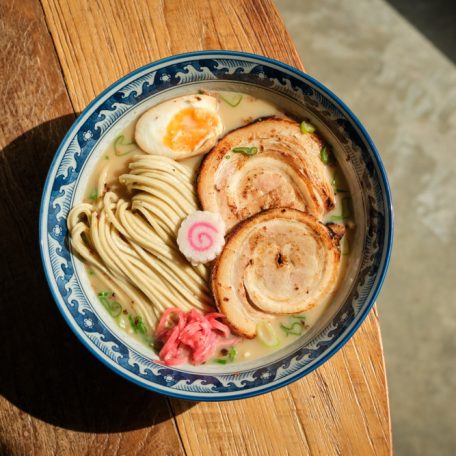7 Types of Must Try Japanese Noodles
Dec 2, 2019
BY Thomas Chang

Noodles are a staple food in Japan. Referred to as “men”(麺), it’s as common as rice and enjoyed in many different ways such as in broth, dipped, mixed, or fried. This article will explore 7 types of noodles along with how they are different and interesting facts about them. Let’s get started, shall we?

1 – Ramen
Ramen is the most popular type of noodle in Japan. Ramen is a thin, wheat-based noodle, and one can easily come across specialty ramen shops all throughout Japan. The most common way that it’s enjoyed is in a broth along with other toppings such as egg, bamboo shoot, meat, and bean sprouts. Some popular broths include shoyu (soy sauce), shio (salt), miso (fermented soybean paste), and tonkotsu (pork broth).
There are other variations of ramen including the dipping ramen (tsukemen) and the mixing ramen (mazemen). You can enjoy local unique flavors of ramen in areas such as Hokkaido, Fukuoka, Tokyo, Kagoshima, Tokushima, Yamagata, Fukushima, and Hiroshima to name a few.

2 – Udon
Udon noodles are most recognizable for having the thickest cut of all Japanese noodle varieties. Udon is a wheat-based noodle that can be served either hot or cold. In a typical udon restaurant, udon can be as cheap as 300 yen and topped with green onions and fried tempura batter called tenkasu. Udon is often eaten with tempura fried vegetables or meat on the side.

3 – Soba
Soba noodles are another common type of noodle in Japan and are made up of buckwheat and wheat flour. Soba is eaten in almost the exact same way as udon, and oftentimes the only difference in a dish is whether the noodles are udon or soba.
Zaru Soba is one of the most common soba dishes and is essentially soba noodles served on a bamboo mat dipped in a soy sauce-based broth. Soba noodles can also be stir fried with meat and vegetables to make the famous yakisoba.
There are many health benefits to eating the buckwheat noodles. They can be a good source of protein, help lower blood sugar levels and risk of heart disease, and much more. Nagano, Shimane, and Iwate are known to have delicious soba, so we recommend getting some if you’re in the area!

4 – Somen
Sōmen noodles are white in color, relatively thin, and are wheat/flour based. Sōmen is usually prepared cold with toppings and dipping sauce as a popular summer meal, but they are often eaten as a warm dish during the winter as well.
There’s an interesting way to eat sōmen called Nagashi Sōmen which involves a long bamboo water slide. The sōmen is sent down the slide in small bundles and you have to catch it with your chopsticks in the middle of the slide and bring it to your plate.
Nagashi Sōmen is most famous in Kagoshima, but there are sōmen restaurants in big cities such as Osaka and Tokyo so we highly recommend trying it if you get the chance!

5 – Shirataki
Shirataki noodles are thin and appear to be completely translucent in appearance. The noodles are made of konjac yam and have a very low calorie and carbohydrate count. Despite the lack of calories, they are incredibly filling and have been described as a weight loss noodle dish. Some health benefits to shirataki include balanced blood sugar and healthy cholesterol levels.

6 – Harusame
Harusame noodles are transparent in color and are made of either mung bean starch, potato starch, or sweet potato starch. These noodles are sugar- and fat-free, so if you are diabetic, this noodle dish is completely safe to consume. There is protein, iron, niacin, and selenium in low percentages within just a single serving.
Harusame is often served as a salad along with ingredients like egg, ham, cucumber, carrots, shiitake mushrooms, and cooked ground beef. It is encouraged to refrigerate the salad before serving, creating the perfect cold side dish during the summer months. Harusame noodles are also used to create hot pot dishes served in broth if you opt out of the cold salad variation.

7 – Hiyamugi
Hiyamugi noodles are similar in appearance to udon noodles in size, but are more translucent in color when prepared correctly. You can also enjoy hiyamugi noodles colored pink and/or green to add visual appeal to your dish. The noodles are wheat based and often enjoyed with fresh cucumber, tomatoes, ginger, hard boiled eggs, and/or green onions on the side. Hiyamugi noodles can also be served in chicken or beef broth with bean sprouts and thinly sliced pork.
Join our Ultimate Ramen Tasting Tour in Tokyo with a Ramen expert to learn about Ramen history, facts and eating tips!
Book your pocket wifi now to stay connected through your entire Japan Journey!

Book your pocket wifi now to stay connected through your entire Japan Journey!

Be sure to get the JR Pass to make navigating Japan during your trip that much easier!

YOU MIGHT ALSO LIKE




